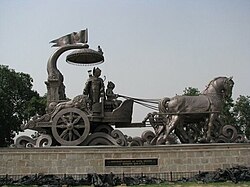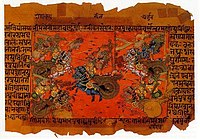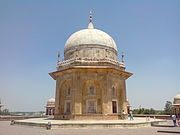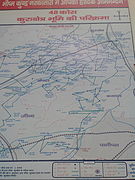Kurukshetra
This articleneeds additional citations forverification.(February 2015) |
Kurukshetra
Dharmakshetra | |
|---|---|
City | |
 | |
| Nickname: Land of the Bhagavad Gita | |
| Coordinates:29°57′57″N76°50′13″E/ 29.965717°N 76.837006°E | |
| Country | |
| State | Haryana |
| District | Kurukshetra |
| Named for | King Kuru |
| Area | |
| • Total | 48 km2(19 sq mi) |
| Languages[1][2] | |
| • Official | Hindi |
| • Additional official | English,Punjabi |
| Time zone | UTC+5:30(IST) |
| PIN | 136118 |
| Telephone code | 01744 |
| ISO 3166 code | IN-HR |
| Vehicle registration | HR-07 |
| Website | kurukshetra |
Kurukshetra(Hindi pronunciation:[kʊrʊkʃeːtɾə],) is acityand administrative headquarters ofKurukshetra districtin theIndianstate ofHaryana.It is also known asDharmakshetra( "Realm of duty" ) and as the "Land of theBhagavad Gita".
Legends[edit]

According to thePuranas,Kurukshetra is a region named afterKing Kuru,the ancestor of Kauravas and Pandavas in theKuru kingdom,as depicted in epicMahabharata.TheKurukshetra Warof theMahabharatais believed to have taken place here.Thaneswarwhose urban area is merged with Kurukshetra is a pilgrimage site with many locations attributed toMahabharata.[3]
In the Vedas Kurukshetra is described not as a city but as a region ( "kshetra"means" region "in Sanskrit). The boundaries of Kurukshetra correspond roughly to the central and western parts of the state ofHaryanaand Punjab. According to theTaittiriya Aranyaka5.1.1., the Kurukshetra region is south of Turghna (Srughna/Sugh inSirhind,Punjab), north ofKhandava(Delhi andMewatregion), east ofMaru(desert), and west of Parin.[4]
According to theVamana Purana,King Kuru chose land at the banks of theSarasvati Riverfor embedding spirituality with eight virtues: austerity (Tapas), truth (Satya), forgiveness (Kshama), kindness (Daya), purity (Shuddha), charity (Daana), devotion (Yajna), and conduct (Brahmacharya). LordVishnuwas impressed with the acts of King Kuru and blessed him with two boons—first, that this land forever will be known as a Holy Land after his name as Kurukshetra (the land of Kuru); second that anyone dying on this land will go to heaven.
The land of Kurukshetra was situated between two rivers—theSarasvatiand theDrishadvati.
History[edit]
Kuru Kingdom,founded byKing Puru—the ancestors ofKauravasandPandavasVedicIndo-Aryantribal union in northernIron Age[5][6](c. 1200 – c. 900 BCE), developed into the first recordedstate-level society(janapada) in theIndian subcontinent.[7][8][9]This kingdom documented their ritual hymns into collections called theVedas,and developed new rituals which gained their position inIndian civilizationas theSrautarituals,[7]which contributed to the "classical synthesis"[9]or"Hindu synthesis"(roots of Hinduism).[10]It was the dominant political and cultural center of the middle Vedic Period during the reigns ofParikshitandJanamejaya,[7]but declined in importance during the late Vedic period (c. 900 – c. 500 BCE) and had become "something of a backwater"[9]by theMahajanapada periodin the 5th century BCE. Traditions and legends about the Kurus continued into the post-Vedic period, providing the basis for theMahabharataepic.[7]The time-frame and geographical extent of the Kuru kingdom (as determined byphilological studyof the Vedic literature) corresponds with the archaeologicalPainted Grey Ware culture.[9]
Kurukshetra was conquered by theMauryanempire in the late 4th century BCE and subsequently became a center of Buddhism and Hinduism. The history of Kurukshetra is little-known in between the collapse of the Mauryans and the rise of theKushanswho conquered the region. After the decline of Kushan power in the region, Kurukshetra became independent only to become conquered by theGupta empirein the early 4th century CE. Under Gupta rule, Kurukshetra experienced a cultural and religious revival and became a center for Hinduism. After the fall of the Gupta, thePushyabhuti dynastyruled over Kurukshetra.[11]
Kurukshetra reached the zenith of its progress during the reign of KingHarsha(c. 590–647 CE) during which Chinese scholarXuanzangvisited Thanesar. Civil war broke out when Harsha (of the Pushyabhuti dynasty) died without a successor in 647. A Kashmiri army briefly conquered Kurukshetra in 733 but were unable to establish dominion in the area. In 736, theTomara dynastywas founded and they took over the region. Around the early 9th century, Kurukshetra lost its independence to Bengal.Mahmud of Ghaznisacked Kurukshetra in 1014 and Muslim raiders sacked it in 1034. Kurukshetra was incorporated into theDelhi Sultanatein 1206. Other than a short moment of independence from the result of a rebellion within the Sultanate in 1240, Kurukshetra was under the control of Delhi until 1388.[11]
Kurukshetra became independent once again after the steep decline of the Delhi Sultanate and the raids ofTamerlanenear the region. TheSayyid dynastyincorporated Kurukshetra into their territory though the city likely enjoyed some autonomy. The area was much more firmly controlled under the subsequentLodi dynasty.Some damages to Kurukshetra and its structures occurred during this period. Kurukshetra became part of theMughal EmpireafterBaburquashed a local rebellion in 1526. UnderAkbar,Kurukshetra once again became a spiritual center not only for Hindus but also for Sikhs and Muslims.[11]
Between the late 17th and early 18th centuries, Kurukshetra was controlled by the forces of theMaratha Empireuntil the British took over Delhi in 1803. In 1805, the British took Kurukshetra after defeating the Maratha forces in theSecond Anglo-Maratha War,who were controlling the city. Since 1947, Kurukshetra has become a popular spiritual center and has seen much infrastructure, development, and restoration of old structures.[11]
Geography[edit]
Kuruksetra is located at around 30° North and 77° East.
Kurukshetra city is surrounded byPatiala,Ludhiana,Jalandhar,Amritsarto the northwest,Ambala,Chandigarh,Shimlato the north,Yamuna Nagar,Jagadhri,Dehradunto the northeast,Pehowa,Cheeka,Mansato the west,Ladwa,Saharanpur,Roorkeeto the east,Kaithal,Jind,Hisarto the southwest,Karnal,Panipat,Sonipat,New Delhito the south, andShamli,Muzaffarnagar,Meerutto the southeast.
Climate[edit]
The climate of the district varies as the temperature in summer reaches as high as 47 °C (117 °F), and as low 1 °C (34 °F) in winter, with rains in July and August.
Demography[edit]
Religion in Kurukshetra city (2011)[12]
In 2017, the government declared Kurukshetra a holy city and the sale, possession, and consumption of meat are banned within the limits of the Municipal Corporation due to its religious significance.[13]
Transport[edit]
Kurukshetra Junction railway stationis ajunction stationat the junction ofDelhi–Kalka lineand Kurukshetra–Jind branch line.[14]It serves Kurukshetra andThanesarcity.
Tourism[edit]
Kurukshetra is an important Hindu pilgrimage destination, and there are several pilgrimage sites surrounding the city. TheHindiphrase48 kos parikramarefers to a roughly 90-km traditional circle (Parikrama) around the holy city (1 kos equals about 3.00 km or 1.91 miles), and a completeparikramarefers to a pilgrimage to all these sites on foot.[15][16]The InternationalGita Mahotsav,held every year in Kururukshetra on theShuklaEkadashi—the 11th day of thewa xing moonof theMargashirsha(Agrahayan) month of theHindu calendar,celebrates the dayBhagavad Gitawas revealed toArjunabyKrishnain thebattlefield ofKurukshetra.[17]
Hindu religious sites[edit]
- Brahma Sarovar:Every yearlakhs(hundreds of thousands) of people come to take a holy bath at Brahma Sarovar on the occasion of "Somavati Amavasya" (Sacred No-Moon Day that happens on a Monday) and on solar eclipses. They believe that a bath in the holy Sarovar frees all sins and cycle of birth-death. The Sarovar is one of Asia's largest man-made ponds.[18]Hindu genealogy registersare kept here.
- Sannihit Sarovar:The pond is believed to be the meeting point of seven sacred Saraswatis. The Sarovar, according to popular belief, containssacred water.Bathing in the waters of the tank on the day of Amavasya (night of complete darkness) or on the day of an eclipse bestows blessings equivalent to performing the Ashvamedh Yajna.
- Jyotisar:The famous site whereBhagavad Gitawas delivered to Arjuna under the tree. The tree of that time is witness to Gita.
- Sthaneshwar Mahadev Temple
Museums[edit]
- Kurukshetra Panorama and Science Centre:A mural depiction of the Mahabharata war.
- Dharohar Museum:A museum about the tradition and cultural depiction of Haryana located inKurukshetra University.
Historical sites[edit]
- Sheikh Chilli's Tomb:This monument is maintained by theArchaeological Survey of India.It was built during theMughal erain remembrance of Sufi Saint Sheikh Chehli, believed to be the spiritual teacher of Mughal PrinceDara Shikoh.The Prince's main 'Murshid' or 'Sheikh' (Spiritual Guide), however, is historically known to have been Hazrat SheikhMian MirSahib, ofLahore,[19]although Sheikh Chehli might have been an additional teacher. Another theory is that the site of the so-calledmaqbaraor tomb. Sheikh Chaheli’s Tomb and the madarasa are associated with the Sufi saint Abdu'r-Rahim alias Aabd-ul-Razak, popularly known as Shaikh Chehli (also pronounced Chilli).[20]
- The Pathar Masjid is built of red sandstone and is known for its fluted minaret.
- Nabha House,a palatial building was constructed by the royal family of Nabha principality.[21]
Wildlife[edit]
Educational institutes[edit]
- Kurukshetra University
- National Institute of Design
- National Institute of Technology, Kurukshetra
- Shri Krishna AYUSH University
- University Institute of Engineering and Technology, Kurukshetra University
- State Institute of Advance Studies in Teacher Education, Kurukshetra[22]
- Govt. Polytechnic, Umri
- National Institute of Electronics & Information Technology, Kurukshetra[23]
Politics[edit]
- Nayab Singh Sainiis the currentMember of Parliamentof17th Lok Sabhafor Kurukshetra.[24]Before himRaj Kumar Sainiwas theMember of Parliamentof16th Lok Sabha.
District administration[edit]
- TheDeputy Commissioner,an officer belonging to theIndian Administrative Service,is in charge of the General Administration in thedistrict.He is assisted by a number of officers belonging to Haryana Civil Service and other Haryana state services.
- TheSuperintendent of Police,an officer belonging to theIndian Police Service,is responsible for maintaining Law & Order and related issues in the district. He is assisted by the officers of the Haryana Police Service and other Haryana Police officials.
- The Deputy Conservator of Forests, an officer belonging to theIndian Forest Service,is responsible for the management of the Forests, Environment, and Wildlife in the district. He is assisted by the officers of the Haryana Forest Service and other Haryana Forest officials and Haryana Wildlife officials.
- Sectoral development is looked after by the district head/officer of each development department such as PWD, Health, Education, Agriculture, Animal Husbandry, Statistics, etc. These officers are from various Haryana state services.
- Shahbad,Ladwa,Pehowa,Babain, Ismailabad, andJhansaare other towns in the district with significant populations.
In popular art[edit]
Ramdhari Singh 'Dinkar'wrote anepic poemtitledKurukshetra,a narrative poem based on theSanti Parvaof theMahabharata.He wrote the poem when memories of theSecond World Warwere fresh in his mind.[25]
Notable people[edit]
- Nayab Singh Saini,Member of ParliamentofKurukshetra
- Dr. Pawan Saini,doctor, academician,social activistand formerMLAofLadwa
- Raj Kumar Saini,formerMember of ParliamentfromKurukshetraof16th Lok Sabha
- Sandeep Singh Saini,former captain of Indian Hockey team, currentMLAfromPehowaandSports Minister of Haryana
- Kailasho Devi Saini,politician and formerMember of Parliament
- Surinder Kaur,Hockey player and member of thenational field hockey team
- Rohit Sardana,journalist, anchor and media personality
- Sanjay Chaudhary,HUM Foundation, Social Activist
Gallery[edit]
-
The statue of Arjun at the Arjun Chowk
-
Brahma Sarovar
-
Bhishma Kund
-
Sheikh Chilli Tomb
-
Sheikh Chilli Maqbara.
-
Map depicting all the48 kos parikramasites displayed atBan Ganga/Bhishma Kund
-
Sudarshan Chakra Chowk near NIT
-
Bronze Chariot with Lord Krishna and Arjuna in Kurukshetra
References[edit]
- ^"Report of the Commissioner for linguistic minorities: 52nd report (July 2014 to June 2015)"(PDF).National Commission of Linguistic Minorities, India.Commissioner for Linguistic Minorities, Ministry of Minority Affairs, Government of India. pp. 85–86. Archived fromthe original(PDF)on 15 November 2016.Retrieved24 March2019.
- ^IANS(28 January 2010)."Haryana grants second language status to Punjabi".Hindustan Times.Archivedfrom the original on 5 November 2018.Retrieved24 March2019.
- ^"Kurukshetra (India)".Encyclopædia Britannica.Archivedfrom the original on 10 August 2014.Retrieved9 August2014.
- ^Agarwal, Vishal: Is There Vedic Evidence for the Indo-Aryan Immigration to India?Archived28 May 2008 at theWayback Machine
- ^Pletcher 2010,p. 63.
- ^Witzel 1995,p. 6.
- ^abcdWitzel 1995.
- ^B. Kölver, ed. (1997).Recht, Staat und Verwaltung im klassischen Indien[Law, State and Administration in Classical India] (in German). München: R. Oldenbourg. pp. 27–52.
- ^abcdSamuel 2010.
- ^Hiltebeitel 2002.
- ^abcdSchellinger, Paul; Salkin, Robert, eds. (1996).International Dictionary of Historic Places, Volume 5: Asia and Oceania.Chicago: Fitzroy Dearborn Publishers. pp. 507–508.ISBN1-884964-04-4.
- ^"Kurukshetra Population 2021".Archivedfrom the original on 19 December 2022.Retrieved19 January2022.
- ^"Haryana bans meat in holy towns of Kurukshetra, Pehowa".The Indian Express.25 August 2012.Archivedfrom the original on 9 April 2024.Retrieved31 March2013.
- ^"KKDE/Kurukshetra Junction Railway Station".India Rail Info.Archivedfrom the original on 13 April 2021.Retrieved29 August2014.
- ^"Archived copy".Archived fromthe originalon 25 June 2016.Retrieved30 May2016.
{{cite web}}:CS1 maint: archived copy as title (link) - ^Service, Tribune News."K'shetra village renamed after Mahabharata's Abhimanyu".Tribuneindia News Service.Archivedfrom the original on 9 April 2024.Retrieved29 December2019.
- ^"Bhagavad-Gita: Chapter".bhagavad-gita.org.Archivedfrom the original on 2 September 2022.Retrieved2 September2022.
- ^Aggarwal, Chandni."Brahma Sarovar".The Times of India.Archivedfrom the original on 29 September 2019.Retrieved3 September2019.
- ^Lahore Gazetteer, 1887, p. 203
- ^"Sheikh Chaheli's Tomb | Places of Interest | Kurukshetra | Destinations | Haryana Tourism Corporation Limited".Haryana Tourism Corporation.Haryana Government.Archivedfrom the original on 5 January 2021.Retrieved26 January2021.
- ^"Nabha House | Places of Interest | Kurukshetra | Destinations | Haryana Tourism Corporation Limited".Haryana Tourism Corporation.Archivedfrom the original on 26 July 2021.Retrieved26 January2021.
- ^"Archived copy".Archivedfrom the original on 19 July 2023.Retrieved19 July2023.
{{cite web}}:CS1 maint: archived copy as title (link) - ^"Archived copy".Archivedfrom the original on 19 July 2023.Retrieved19 July2023.
{{cite web}}:CS1 maint: archived copy as title (link) - ^"Nayab Singh(Bharatiya Janata Party(BJP)):Constituency- KURUKSHETRA(HARYANA) - Affidavit Information of Candidate".myneta.info.Archivedfrom the original on 28 June 2021.Retrieved1 September2020.
- ^Das, Sisir Kumar (1995).A History of Indian literature.Sahitya Akademi.p. 908.ISBN978-81-7201-798-9.
Sources[edit]
- Hiltebeitel, Alf (2002),Hinduism. In: Joseph Kitagawa, "The Religious Traditions of Asia: Religion, History, and Culture",Routledge,ISBN9781136875977,archivedfrom the original on 11 January 2023,retrieved2 September2022
- Pletcher, Kenneth (2010),The History of India,The Rosen Publishing Group,ISBN9781615301225,archivedfrom the original on 9 April 2024,retrieved2 September2022
- Samuel, Geoffrey (2010),The Origins of Yoga and Tantra. Indic Religions to the Thirteenth Century,Cambridge University Press
- Witzel, Michael (1990),"On Indian Historical Writing"(PDF),Journal of the Japanese Association for South Asian Studies,2:1–57,archived(PDF)from the original on 8 December 2021,retrieved2 September2022
- Witzel, Michael (1995),"Early Sanskritization: Origin and Development of the Kuru state"(PDF),EJVS,1(4), archived fromthe original(PDF)on 11 June 2007
External links[edit]
- Official website
- Kurukshetraon the Tourism department website of the Haryana Government















